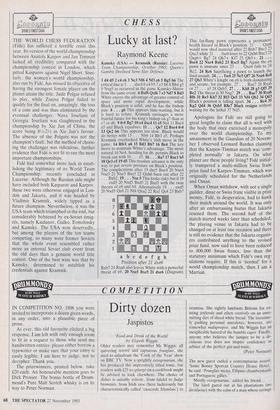1 8 SPAIN'S FINEST CAVA
CHESS
SPAIN'S FINEST CAVA THE WORLD CHESS FEDERATION (Fide) has suffered a terrible crisis this year. Its version of the world championship between Anatoly Karpov and Jan Timman lacked all credibility compared with the championship contest in London. which pitted Kasparov against Nigel Short. Simi- larly, the women's world championship, also run by Fide, has missed its objective of having the strongest female player on the planet attain the title. Judit Polgar refused to play, while Zsuzsa Polgar failed to qualify for the final on, amazingly, the toss of a coin and was thus eliminated by the eventual challenger, Nana Ioseliani of Georgia. Ioseliani was slaughtered in the championship by Xie Jun of China, the score being 81/2-21/2 in Xie Jun's favour. The absence of the Polgars was not the champion's fault, but the method of choos- ing the challenger was ridiculous, further evidence that Fide is not fit to run the most important championships.
Fide had somewhat more luck in estab- lishing the legitimacy of its World Team Championship, recently concluded in Lucerne. Although the Russian side might have included both Kasparov and Karpov, these two were otherwise engaged in Lon- don and Jakarta, and it was headed by Vladimir Kramnik, widely tipped as a future champion. Nevertheless, it was the USA team which triumphed in the end, but considerably bolstered by ex-Soviet émig- rés, namely Kaidanov, Gulko, Ermolinsky and Kamsky. The USA won deservedly, but among the players of the ten teams competing, so many were former Soviets that the whole event resembled rather more an internal Soviet club event from the old days than a genuine world title contest. One of the best wins was that by Kamsky, determined to establish his credentials against Kramnik.
Lucky at last?
Raymond Keene
Kamsky (USA) — Kramnik (Russia): Lucerne Team Championship, October 1993; Queen's Gambit Declined Semi-Slav Defence.
1 d4 d5 2 c4 c6 3 Nc3 Nf6 4 Nf3 e6 S Bg5 h6 The critical line is 5 . . dxc4 6 e4 b5 7 e5 h6 8 Bh4 g5 9 Nxg5 as occurred in the game Kamsky-Shirov from the same event. 6 Bxf6 Qxf6 7 e3 Nd7 8 Bd3 White enjoys the advantage of greater control of space and more rapid development, while Black's position is solid, and he has the bishop pair. 8 . . . g6 This appears time-wasting, but it is hard to refute. Kramnik envisages a more fruitful future for his king's bishop on g7 than at e7 or d6. 9 0.0 Bg7 10 e4 dxc4 11 e5 Not 11 Bxe4 e5 and Black equalises. 11 . . Qe7 12 Bxe4 0-0 13 Qe2 b6 This appears too slow. Black would do better with 13 . . Nb6 14 Bb3 c5. Perhaps Kramnik overlooked White's 16th move in the game. 14 Rfel a6 15 Bd3 Bb7 16 Be4 The key move to maintain White's advantage. The more natural 16 Ne4, heading for d6, permits Black to break out with 16 . . . c5. 16 . . . Ra7 17 Rad b5 18 Qe3 c5 19 d5 This resolute advance is the only way to put severe pressure on Black's ,position. The complications after 19 dxc5 Bxe4 20 Nxe4 Nxe5 21 Nxe5 Bxe5 22 Qxh6 burn out after 22 . . . Bxb2. 19 . . . Nxe 5 This looks risky but if 19 . . . exd5 20 Nxd5 Bxd5 21 Bxd5 with the twin threats of e6 and b4. Alternatively 19 . . exd5 20 Nxd5 Qe6 21 Nf4 Qxa2 22 Ral Qc4 23 Bxb7
Position after 21 dxe6 Rxb7 24 Rxa6 also leaves White with a powerful threat of e6. 20 Nxe5 Bxe5 21 dxe6 (Diagram) This far-flung pawn represents a permanent health hazard to Black's position. 21 . . . Oxe6 would now shed material after 22 Bxb7 Bxc3 23 Qxc3 while 21 . . . fxe6 loses to 22 Qxh6 Bxc3 23 Qxg6+ Bg7 24 Qh7+ Kf7 25 Qh5+ . 21 . • • Bxe4 22 Nxe4 Bxb2 23 RxcS Bg7 Again the e6 pawn is immune since 23 . . . Oxe6 fails to 24 Rc2. 24 Re6 Sacrificing a pawn to launch the final assault. 24 . . fxe6 25 Nc5 Qf7 26 Nxe6 Re8 27 Qb3 White's knight on e6 is both dominating and secure, for example, 27 . . Rae7 28 Rxa6 or 27 . . . a5 28 Qxb5. 27 . . . KhS 28 g3 Qf5 29 Reg The threat is 30 Nxg7. 29 . . Rae7 30 Rxa6 Bf6 31 Re3 Kh7 32 Rf3 Qe5 33 Nf4 Qb2 34 Qd3 Black's position is falling apart. 34 . . . Re4 35 Kg2 Qd4 36 Qxh5 R8e7 Black resigns without waiting for the lethal 37 Nd5.
Apologists for Fide are still going to great lengths to claim that all is well with the body that once exercised a monopoly over the world championship. To my amazement in the Guardian of 20 Novem- ber 1 observed Leonard Barden claiming that the Karpov-Timman match was 'com- pleted normally' in Jakarta. On what planet are these people living? Fide initial- ly trumpeted a multi-million Swiss franc prize fund for Karpov-Timman, which was originally scheduled for the Netherlands and Oman.
When Oman withdrew, with not a single guilder, dinar or Swiss franc visible in prize money, Fide, in desperation, had to hawk their match around the world. It was only after an embarrassing hiatus that Jakarta rescued them. The second half of the match started weeks later than scheduled, the playing venue in Jakarta had to be changed on at least one occasion and there is still no evidence that the Jakarta organis- ers contributed anything to the revised prize fund, now said to have been reduced to 800,000 Swiss francs, less than the statutory minimum which Fide's own reg- ulations require. If this is 'normal' for a world championship match, then 1. am a Martian.










































































 Previous page
Previous page